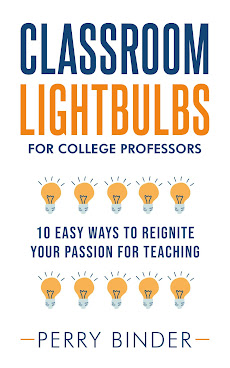On the first day of
class, I arrive at the classroom before students get there. As you can see in
the pic, I place index cards at each seat. (Most of my classrooms are not this fancy:)
Icebreaker to Start Class
On the doc cam, I display the first page of the syllabus, which asks students to fill out the Index Cards with:
- Name
- Favorite movie or TV show dealing with LAW
- Law topic of
interest
This is my icebreaker. I do this in class sizes ranging from 35-120 students. It gets students talking before the content. After I collect the cards, I start with:
“Welcome everyone to [fill in the class]. My name is Perry Binder and I’ll give you my background after I meet each of you.”
Then, one by one, I’ll read the name and movie or TV show and topic of interest, with a chance for the student to elaborate. There is more than enough time in a 75-minute class to personally address each index card, up to 60 students. I’m unable to do that in classes of 120 students, but I’ll still read aloud the movie or TV show from every index card. When I find interesting ones or ones I’ve never heard of, I’ll look for those students and ask them questions.
In a class of 45 students, the icebreaker takes about 20 minutes.
Once I’m done with the index cards, I’ll re-mention my name and give them my background, where I grew up, went to college and law school, where I practiced law, how I got into teaching, when I got to this institution, the classes I teach, and the interactions I have in the professional community. Next, I ask the following questions:
“Is this anyone’s first semester at this college?”
“Is anyone here a graduating senior?”
“Is there anyone here who doesn’t know one person in this room?”
To the first question, I offer a sincere welcome; for the second, I lead the class in a round of applause for those people; and for the third, I tell students that we are taking a five-minute break for you to speak with the individuals next to you, and maybe exchange contact information for notes missed in the future. The once-silent classroom becomes loud and joyous.
* * *
Other than developing a rapport with students, I have an ulterior motive for the index card exercise, which unfolds all semester long: Hollywood portrays law cases that are neatly wrapped up in an hour or two, while the reality is much different. I attempt to demystify the legal process by showing how it is slow and easily manipulated, with mixed results for parties to a lawsuit.
Click Here for Innovative College Teaching on Amazon
.jpg)

















.jpg)